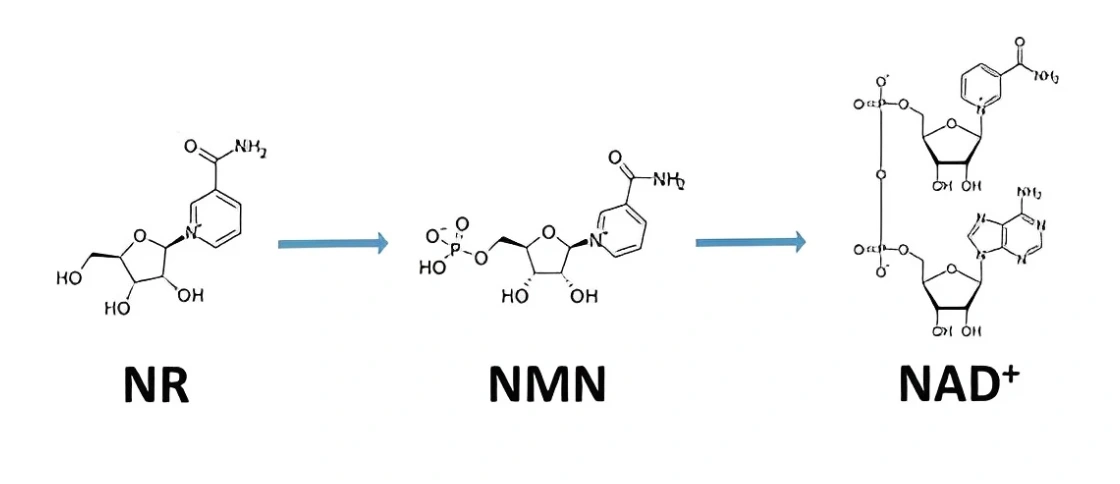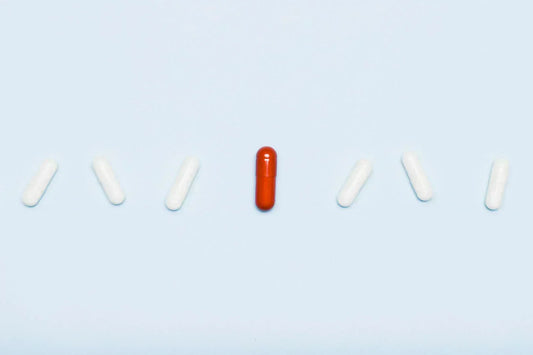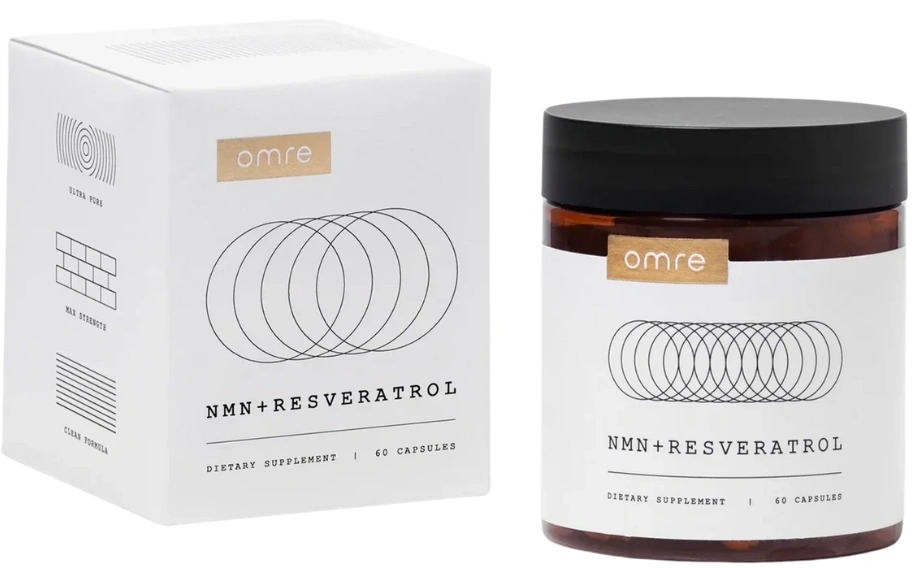Table of Contents
Nicotinamide mononucleotide (NMN) and nicotinamide riboside (NR) are two of the most popular NAD+ precursors used for energy, focus, and longevity.
If you’ve been wondering whether you can take NMN and NR together, the answer isn’t as simple as yes or no.
While both raise NAD+ levels, they work through slightly different steps in the body. This guide explains how they interact, what science says about stacking them, and how to use them safely.
Key Summary:
-
NMN and NR both raise NAD+ levels, which support energy, brain health, and cellular repair.
-
Taking them together is considered safe, but there are no studies showing that it’s more effective than taking one alone.
NMN + RESVERATROL
Cellular NAD+ booster with ultra‑pure NMN and Resveratrol, at research‑backed doses.*
Can You Take NMN and NR Together?
-v1760580567311.webp) You can take NMN and NR together, but it may not give extra benefits for most people. Both supplements increase NAD+ in the body, which supports energy production, DNA repair, and healthy aging. Since they share the same pathway, combining them is usually safe but might be redundant if your goal is simply to raise NAD+.
You can take NMN and NR together, but it may not give extra benefits for most people. Both supplements increase NAD+ in the body, which supports energy production, DNA repair, and healthy aging. Since they share the same pathway, combining them is usually safe but might be redundant if your goal is simply to raise NAD+.
Some people still combine NMN and NR in smaller doses, hoping to target different tissues or enhance absorption. This mix can make sense if you’re experimenting under guidance or tracking NAD+ markers.
However, there’s limited research comparing combined use. Most studies test NMN or NR alone, not together.
If you decide to take both, start with lower doses and consult your doctor, especially if you’re already taking other supplements or medications that affect metabolism.
What Are NMN and NR?
 NMN and NR are vitamin B3 derivatives that help the body make NAD+, a molecule essential for cellular energy and repair. NAD+ levels naturally drop as we age, and supplementing with NMN or NR helps restore them.
NMN and NR are vitamin B3 derivatives that help the body make NAD+, a molecule essential for cellular energy and repair. NAD+ levels naturally drop as we age, and supplementing with NMN or NR helps restore them.
NMN (nicotinamide mononucleotide) is a direct precursor to NAD+. The body only needs one step to turn NMN into NAD+, which makes it fast-acting and efficient.
NR (nicotinamide riboside) converts into NMN first, then becomes NAD+. It’s smaller and easily absorbed, which may give it an edge in reaching certain tissues, such as the brain.
Both have been shown in human and animal studies to raise NAD+ levels, improve energy metabolism, and support healthy aging.
They work differently, but the goal is the same: maintain youthful cellular function and energy.
How NMN and NR Raise NAD+
Both NMN and NR increase NAD+, but they follow different conversion steps inside the body.
When you take NMN, it’s absorbed and turned into NAD+ through a single enzymatic reaction. This happens in tissues such as the liver, muscles, and brain, helping boost energy quickly.
When you take NR, it first becomes NMN, then converts into NAD+. This extra step makes it slightly less direct but still very effective. Some studies also suggest NR crosses the blood-brain barrier better than NMN, potentially supporting brain health.
Here’s a simple breakdown:
NR converts into NMN, which then becomes NAD+.
NMN converts directly into NAD+.
Both routes end with higher NAD+ levels that help power your cells, repair DNA, and activate longevity-related proteins called sirtuins.
Read more: 7 best NMN supplements of 2025 to boost NAD+ and energy
Potential Health Benefits of NMN and NR
-v1760581194904.webp) Both NMN and NR may support energy, brain health, and healthy aging by raising NAD+ levels in the body. While research is still developing, several human and animal studies suggest they might help improve cellular repair, metabolism, and cognitive performance.
Both NMN and NR may support energy, brain health, and healthy aging by raising NAD+ levels in the body. While research is still developing, several human and animal studies suggest they might help improve cellular repair, metabolism, and cognitive performance.
Possible benefits include:
Improved energy metabolism: Studies have found that increasing NAD+ through NMN or NR may enhance how cells convert food into energy, potentially reducing fatigue and improving physical endurance (1).
Better brain function: Research suggests NR might cross the blood-brain barrier more effectively than NMN, possibly helping protect neurons and support cognitive function in aging adults (2).
Healthy aging support: NMN and NR both appear to activate sirtuins, proteins linked to longevity and DNA repair. Animal studies show they might slow down some age-related cellular decline (3).
Metabolic and cardiovascular health: Some studies indicate NAD+ precursors could help regulate blood sugar levels and improve insulin sensitivity, which may benefit metabolic health and heart function (4).
Cellular repair, protection, and anti-aging: NMN and NR may assist the body’s natural repair mechanisms by supporting mitochondrial health and reducing oxidative stress over time (5). These actions could help slow age-related cellular decline and promote healthier, more resilient aging.
Disclaimer: Research on NMN and NR is still ongoing. These potential benefits are based on early studies and should not be taken as medical advice. Always consult a healthcare professional before starting any new supplement.
NMN + RESVERATROL
Cellular NAD+ booster with ultra‑pure NMN and Resveratrol, at research‑backed doses.*
What Happens If You Combine NMN and NR Together?
Taking NMN and NR together is considered safe, but there’s no strong evidence that combining them provides greater benefits than taking either one alone. Both work through similar biochemical pathways that lead to higher NAD+ levels.
When used together, the body still converts both into the same molecule, NAD+. For most people, this means the effects overlap rather than multiply.
Some individuals, however, prefer stacking them in smaller doses, believing it might help with broader tissue coverage.
Researchers haven’t yet confirmed whether this “dual-pathway” approach truly offers added benefits. Until more clinical data is available, it’s best to treat NMN and NR as complementary rather than synergistic supplements.
Read more: What happens when you combine NMN with resveratrol?
Potential Side Effects of NMN and NR
NMN and NR are generally well-tolerated, but some individuals may experience mild side effects, especially when taking high doses. Common side effects include:
Nausea
Headaches
Digestive discomfort
Flushing or skin redness
These side effects are typically temporary and can be minimized by starting with a lower dose and gradually increasing it over time. If you experience severe or persistent side effects, discontinue use and consult a healthcare provider.
Dosage Recommendations
The optimal dosage of NMN and NR can vary depending on factors such as age, weight, and health goals. Here are some general guidelines:
NMN: Most studies use doses ranging from 250 mg to 500 mg per day. Some individuals may benefit from higher doses, but it’s best to start low and adjust as needed.
NR: Typical doses range from 300 mg to 600 mg per day. Like NMN, it’s advisable to start with a lower dose and increase gradually.
If you choose to take both supplements, consider reducing the dosage of each to avoid exceeding your body’s NAD+ requirements. For example, you might take 250 mg of NMN and 300 mg of NR daily instead of the full recommended dose of each.
Should You Take Both or Just One?
-v1760581813377.webp) Most people don’t need to take both NMN and NR. Choosing one supplement and taking it consistently is usually enough to support healthy NAD+ levels.
Most people don’t need to take both NMN and NR. Choosing one supplement and taking it consistently is usually enough to support healthy NAD+ levels.
Those who decide to take both should consider lowering the dosage of each, such as 250 mg of NMN and 300 mg of NR daily, to avoid unnecessary overlap.
Always discuss your plan with a healthcare provider before combining supplements.
Conclusion
NMN and NR are two of the most studied NAD+ precursors today. Both may help support energy, cellular repair, and healthy aging.
Taking them together is generally safe but not necessarily more effective than taking either one alone. For most people, choosing one high-quality supplement and using it consistently will deliver solid results.
If you’re looking to naturally support your energy, focus, and longevity, NMN + Resveratrol can be a powerful combination. Together, they work to enhance NAD+ levels and activate sirtuins, promoting healthy aging from the inside out.
Try Omre NMN + Resveratrol to experience steady energy, sharper focus, and long-term cellular health, one simple routine that helps you feel your best every day.
FAQs
Can I take NMN and NR together every day?
Yes, you can take NMN and NR together daily, as both are generally considered safe. However, since they work through the same NAD+ pathway, taking both every day may not offer extra benefits for most people. It’s best to use moderate doses and monitor how your body responds.
Is it better to alternate NMN and NR?
Alternating NMN and NR on different days can be a practical approach if you want to test which one works better for you. This method helps prevent redundancy while still supporting NAD+ levels consistently.
Can I combine NMN or NR with Resveratrol or TMG?
Many people combine NMN or NR with Resveratrol or TMG for added support. Resveratrol may help activate sirtuins, while TMG can assist with methylation balance, which supports proper NAD+ metabolism.
Does taking both increase NAD+ more?
Current studies haven’t shown that combining NMN and NR significantly increases NAD+ beyond what either can do alone. Both eventually convert into the same molecule, so the effects tend to overlap rather than multiply.
Are there any long-term risks of NAD+ boosters?
So far, research shows NMN and NR are well-tolerated in humans, even with regular use. Still, long-term studies are limited, so it’s wise to use them in moderation and check with a healthcare professional if you have underlying health conditions.






